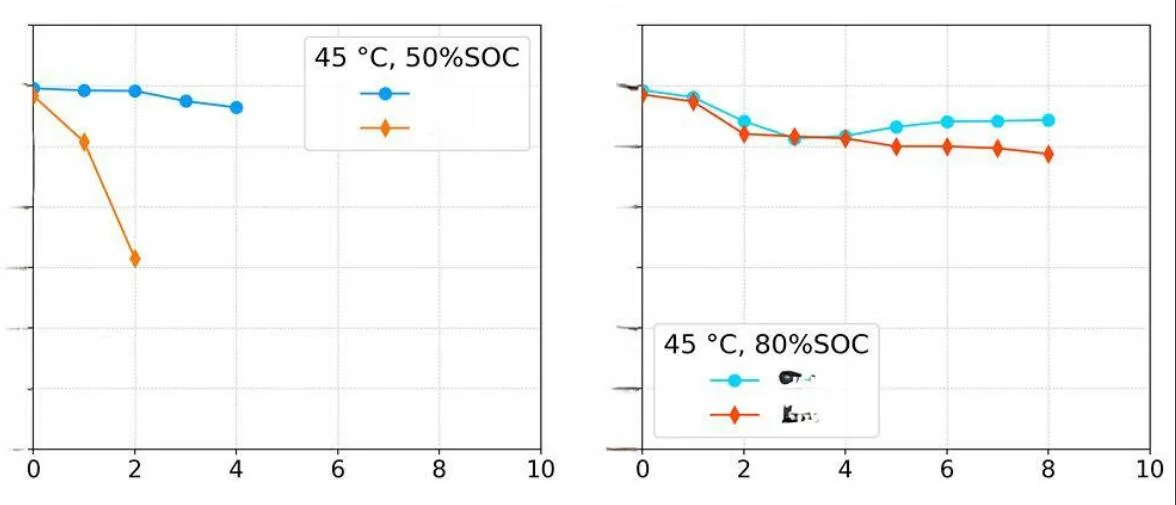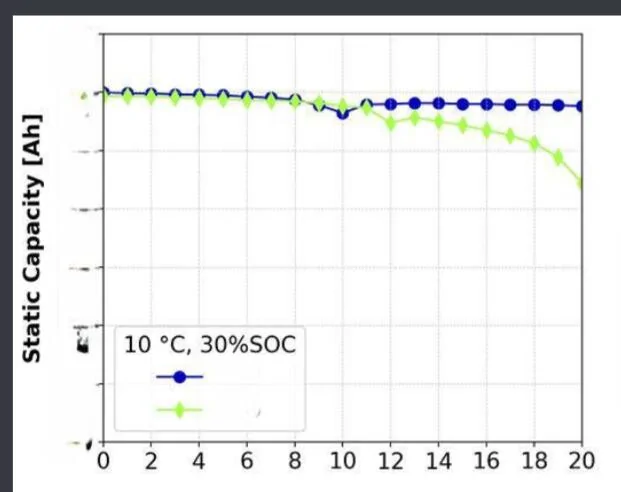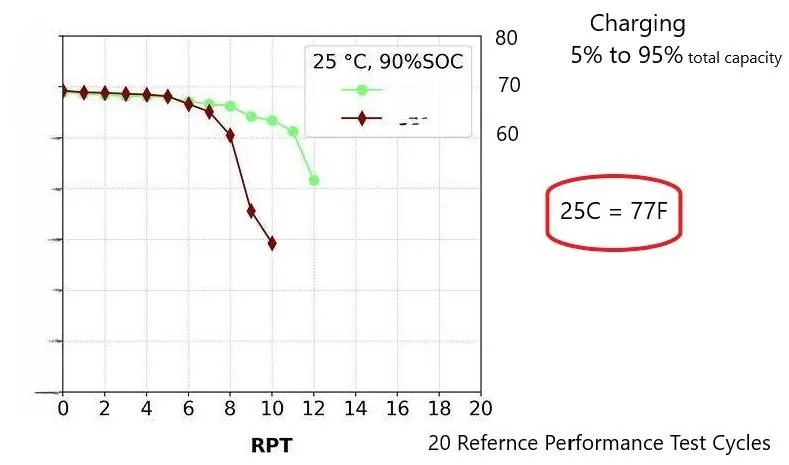MickeyAO
Well-known member
- First Name
- Mickey
- Joined
- Apr 2, 2020
- Threads
- 27
- Messages
- 1,063
- Reaction score
- 2,140
- Location
- San Antonio Tx
- Vehicles
- Rapid Red Lightning Lariat ER, Kia EV6 GT-Line AWD
- Occupation
- Retired Lab Manager of the Energy Storage Technology Center
- Thread starter
- #1
TL;DR you are missing out on actual data that is already summarized as much as I can while presenting the facts about the cells in your truck. I'm not going to summarize it further for you 
So, I recently retired from the Institute (and received my final paycheck with my 8 weeks of vacation being paid out) and the exit documents I signed only talked about trade secrets, so I think it is safe to share some actual (normalized) data explaining what I've been talking about over the last couple of years on this forum.
For the last 14 years I have been testing Li-ion cells from all sorts of chemistries (LTO, LCO, LMO, LFP, NCA, NMC, and others that I can’t talk about, but hopefully you should be hearing about in 3 years if all goes well). My lab was more automotive centric, but I have certified camera battery packs for the space station, tested cells for medical implant devices, and even worked on the project for a 3mW pack for a mining company. I actually got my start in energy storage by working on the control system for a flow battery 16 years ago (my degree is in Computer Science, and what I was originally hired at the Institute for). Over the years I have learned how to kill cells (some clients wanted cells to fail) and how to make them last (virtually) forever, and purposely making them catch fire through abuse testing. I say this to show I’ve been at this awhile and know what I’m doing by observing real time data (and maybe a little patting myself on the back after 2 successful 20 years careers and retirements from the USAF and the Institute ).
).
You all have seen my advice on what is happening with the cells and how to make them last (virtually) forever. I'm sure you have seen all the naysayers who drove EVs for xx number of years and have seen data from the OBD port saying it doesn't matter. Here is some hard actual data.
About the methodology, a Taguchi L9 matrix with 3 charge currents, 3 discharge currents, 3 temperatures, and 3 delta SOC for cycling, with 2 samples per test. The delta is centered on 50% SOC. That means a 30% delta is between 35% and 65% SOC. Despite the varying conditions, all cells end up cycling just about the same kWh of energy throughput. It makes it very easy to see which of the conditions is most dominant in degradation. We are then able to build a mathematical formula that will calculate the lifespan for any type of duty cycle we feed into it. On the side, I ran my own test cycling between 80% (actual so 85% SOC on the display) and 50% SOC. Results closely tracked the cycle 30% delta at 25C as I suspected, but I did not graph it.
Calendar life is 3 temperatures and 3 storage SOCs. When you see 80% SOC on calendar life, it means it sits for 4 weeks at 80% SOC (actual) at the listed temperature.
Cycle life Reference Performance Test (RPT) is performed every week at 25C so we can compare the results across all test coditions. Calendar every 4 weeks at 25C. While we take pulse power and resistance for charge and discharge at 10% SOC increments (90% to 10%), the graphs we produce typically only show discharge pulse power and resistance at 50% SOC. I'm not going to bother showing those graphs. I will show capacity loss based on the test conditions. RPT0 (the first dot) was done before any of our testing started.
We do 10 RPTs for calendar, and 20 for cycle life. We were only at RPT8 for calendar life (RPT9 started on my last week) but have completed cycle life. If you see a test that suddenly has no more dots, then it had to be pulled from testing. In most cases, it was because the cell started to swell (produced off gassing that was trapped in the cell skin). In a couple of cases, the resistance just got too high for us to conduct the RPT…the voltage would shoot past Vmax at the first application of the pulse.
I've normalized the graphs, so you can't see the actual values. I will tell you that RPT0 was just under the rated capacity for the cell (we bought modules from a 3rd party that did some light vehicle testing before pulling the modules to sell to us), and the top of the graph is around 10 Ah above the rated capacity. I'll leave it to the reader to find the rated capacity for the SKE805A... hint, it's in the nomenclature of the name of the cell. BTW, I have 1st hand knowledge that you cannot replace a single cell in a module.
Calendar life started at 25C, 45C, and 55C. The early results from 55C and the previous results of the thermal stability test forced us to use a different temperature for cycle life (I threatened my colleagues that I would stop cycling anytime the cell hit 60C and let the cell cool back down). 10C was chosen as it helped the spread for the model, but I was arguing for 35C as a more real-world condition.
All testing was at actual SOC of the cell without a BMS, so you will have to convert with what the truck reports on the screen. This is accelerated testing, but I have not seen the model (it will be produced in about 10 weeks, and I won't have access to it), but this falls somewhat in line with what I have seen over the last 14 years of cell testing.
For cycling, the 2 dominate conditions on degradation were temperature (very dominate but the BMS should protect you from this) and delta SOC (almost as dominate). Minor degradation conditions were charge and discharge currents (high being the worst for both). Nothing here surprised me EXCEPT for the VERY low thermal stability point (about 35C or more below what I’ve seen in other NMC cells), the 1 calendar condition at 45C (I have never seen where 80% SOC outperformed lower SOCs and made a post about it), and 30% delta at 10C (Li-ion cells don't like being cold, but 30% delta should have been better on sample 2). As my mentor Bapi liked to tell tours, Li-ion cells like the same temperatures humans do.
All this said, your battery has a warranty for 8 years down to 70% capacity loss. This information is only a concern if you plan on keeping the truck for the long term or don't want to go through the hassle of a warranty replacement on the battery.
![Ford F-150 Lightning It's All About the Delta (and Temperature, but the BMS will Protect You) -- Test: Effect of temperature on battery cells life Normalized Cycle Life Static Capacity [Ah]](data:image/svg+xml;charset=utf-8,%3Csvg xmlns%3D'http%3A%2F%2Fwww.w3.org%2F2000%2Fsvg' width='1521' height='1300' viewBox%3D'0 0 1521 1300'%2F%3E)
![Ford F-150 Lightning It's All About the Delta (and Temperature, but the BMS will Protect You) -- Test: Effect of temperature on battery cells life Normalized Calendar Life, Static Capacity [Ah]](data:image/svg+xml;charset=utf-8,%3Csvg xmlns%3D'http%3A%2F%2Fwww.w3.org%2F2000%2Fsvg' width='1549' height='1300' viewBox%3D'0 0 1549 1300'%2F%3E)
So, I recently retired from the Institute (and received my final paycheck with my 8 weeks of vacation being paid out) and the exit documents I signed only talked about trade secrets, so I think it is safe to share some actual (normalized) data explaining what I've been talking about over the last couple of years on this forum.
For the last 14 years I have been testing Li-ion cells from all sorts of chemistries (LTO, LCO, LMO, LFP, NCA, NMC, and others that I can’t talk about, but hopefully you should be hearing about in 3 years if all goes well). My lab was more automotive centric, but I have certified camera battery packs for the space station, tested cells for medical implant devices, and even worked on the project for a 3mW pack for a mining company. I actually got my start in energy storage by working on the control system for a flow battery 16 years ago (my degree is in Computer Science, and what I was originally hired at the Institute for). Over the years I have learned how to kill cells (some clients wanted cells to fail) and how to make them last (virtually) forever, and purposely making them catch fire through abuse testing. I say this to show I’ve been at this awhile and know what I’m doing by observing real time data (and maybe a little patting myself on the back after 2 successful 20 years careers and retirements from the USAF and the Institute
 ).
).You all have seen my advice on what is happening with the cells and how to make them last (virtually) forever. I'm sure you have seen all the naysayers who drove EVs for xx number of years and have seen data from the OBD port saying it doesn't matter. Here is some hard actual data.
About the methodology, a Taguchi L9 matrix with 3 charge currents, 3 discharge currents, 3 temperatures, and 3 delta SOC for cycling, with 2 samples per test. The delta is centered on 50% SOC. That means a 30% delta is between 35% and 65% SOC. Despite the varying conditions, all cells end up cycling just about the same kWh of energy throughput. It makes it very easy to see which of the conditions is most dominant in degradation. We are then able to build a mathematical formula that will calculate the lifespan for any type of duty cycle we feed into it. On the side, I ran my own test cycling between 80% (actual so 85% SOC on the display) and 50% SOC. Results closely tracked the cycle 30% delta at 25C as I suspected, but I did not graph it.
Calendar life is 3 temperatures and 3 storage SOCs. When you see 80% SOC on calendar life, it means it sits for 4 weeks at 80% SOC (actual) at the listed temperature.
Cycle life Reference Performance Test (RPT) is performed every week at 25C so we can compare the results across all test coditions. Calendar every 4 weeks at 25C. While we take pulse power and resistance for charge and discharge at 10% SOC increments (90% to 10%), the graphs we produce typically only show discharge pulse power and resistance at 50% SOC. I'm not going to bother showing those graphs. I will show capacity loss based on the test conditions. RPT0 (the first dot) was done before any of our testing started.
We do 10 RPTs for calendar, and 20 for cycle life. We were only at RPT8 for calendar life (RPT9 started on my last week) but have completed cycle life. If you see a test that suddenly has no more dots, then it had to be pulled from testing. In most cases, it was because the cell started to swell (produced off gassing that was trapped in the cell skin). In a couple of cases, the resistance just got too high for us to conduct the RPT…the voltage would shoot past Vmax at the first application of the pulse.
I've normalized the graphs, so you can't see the actual values. I will tell you that RPT0 was just under the rated capacity for the cell (we bought modules from a 3rd party that did some light vehicle testing before pulling the modules to sell to us), and the top of the graph is around 10 Ah above the rated capacity. I'll leave it to the reader to find the rated capacity for the SKE805A... hint, it's in the nomenclature of the name of the cell. BTW, I have 1st hand knowledge that you cannot replace a single cell in a module.
Calendar life started at 25C, 45C, and 55C. The early results from 55C and the previous results of the thermal stability test forced us to use a different temperature for cycle life (I threatened my colleagues that I would stop cycling anytime the cell hit 60C and let the cell cool back down). 10C was chosen as it helped the spread for the model, but I was arguing for 35C as a more real-world condition.
All testing was at actual SOC of the cell without a BMS, so you will have to convert with what the truck reports on the screen. This is accelerated testing, but I have not seen the model (it will be produced in about 10 weeks, and I won't have access to it), but this falls somewhat in line with what I have seen over the last 14 years of cell testing.
For cycling, the 2 dominate conditions on degradation were temperature (very dominate but the BMS should protect you from this) and delta SOC (almost as dominate). Minor degradation conditions were charge and discharge currents (high being the worst for both). Nothing here surprised me EXCEPT for the VERY low thermal stability point (about 35C or more below what I’ve seen in other NMC cells), the 1 calendar condition at 45C (I have never seen where 80% SOC outperformed lower SOCs and made a post about it), and 30% delta at 10C (Li-ion cells don't like being cold, but 30% delta should have been better on sample 2). As my mentor Bapi liked to tell tours, Li-ion cells like the same temperatures humans do.
All this said, your battery has a warranty for 8 years down to 70% capacity loss. This information is only a concern if you plan on keeping the truck for the long term or don't want to go through the hassle of a warranty replacement on the battery.
![Ford F-150 Lightning It's All About the Delta (and Temperature, but the BMS will Protect You) -- Test: Effect of temperature on battery cells life Normalized Cycle Life Static Capacity [Ah]](https://cdn.f150lightningforum.com/attachments/91/91021-5602eb8154594921cf2ea4824d2a19f8.webp)
![Ford F-150 Lightning It's All About the Delta (and Temperature, but the BMS will Protect You) -- Test: Effect of temperature on battery cells life Normalized Calendar Life, Static Capacity [Ah]](https://cdn.f150lightningforum.com/attachments/91/91022-98edb20d51edf407f972372735beeeb7.webp)
Sponsored
Last edited:




